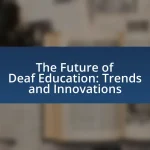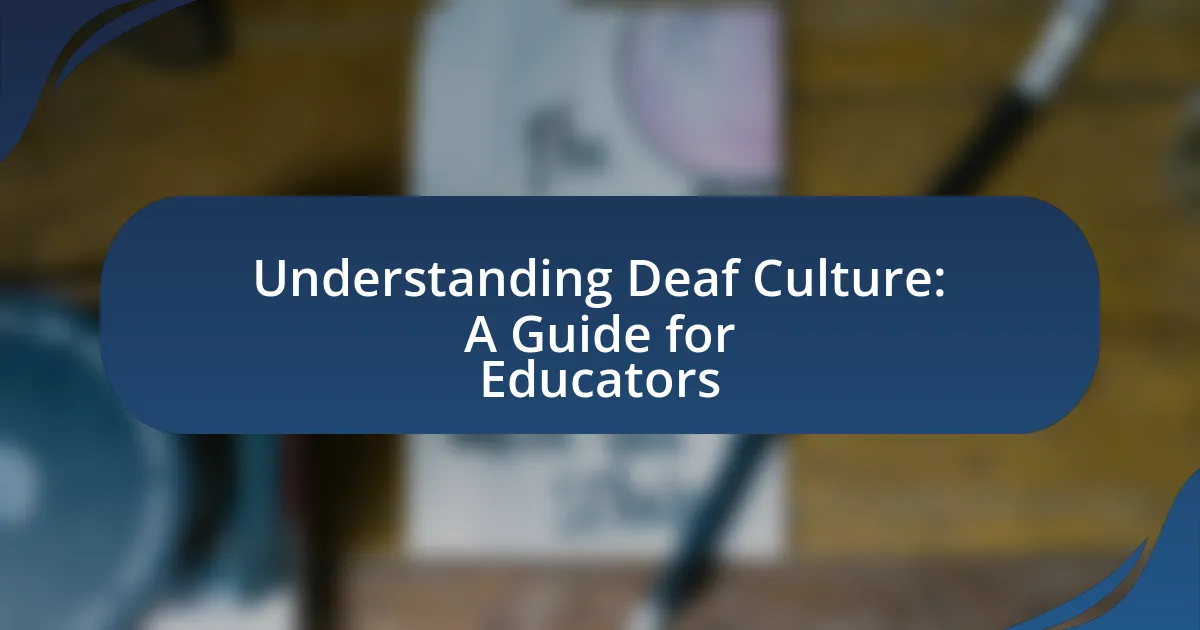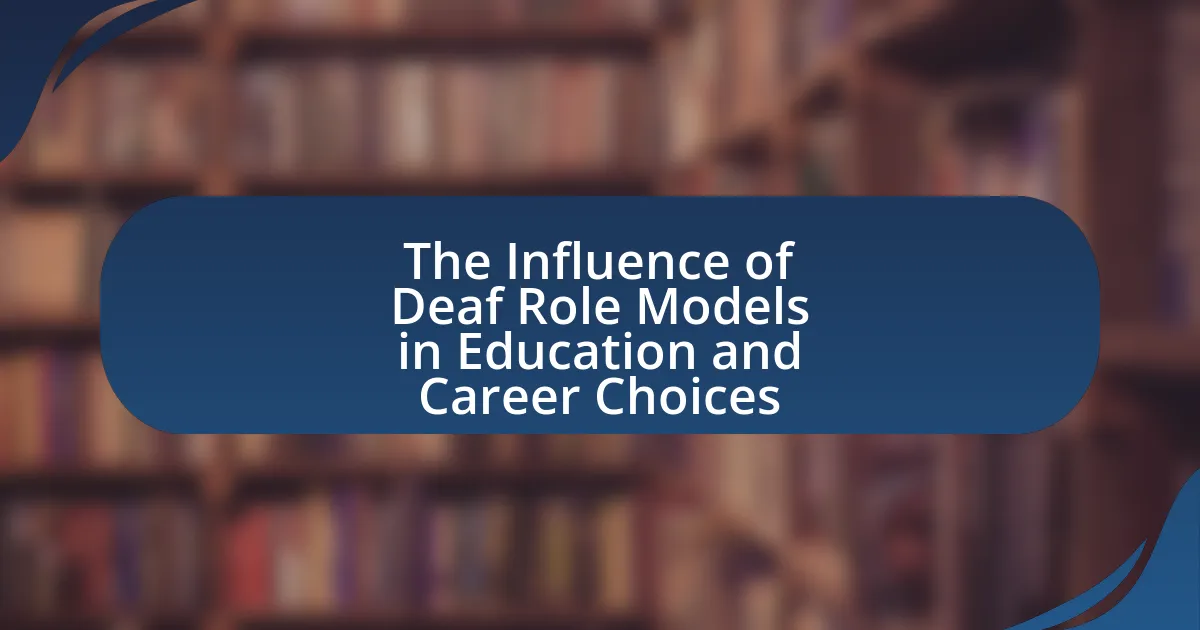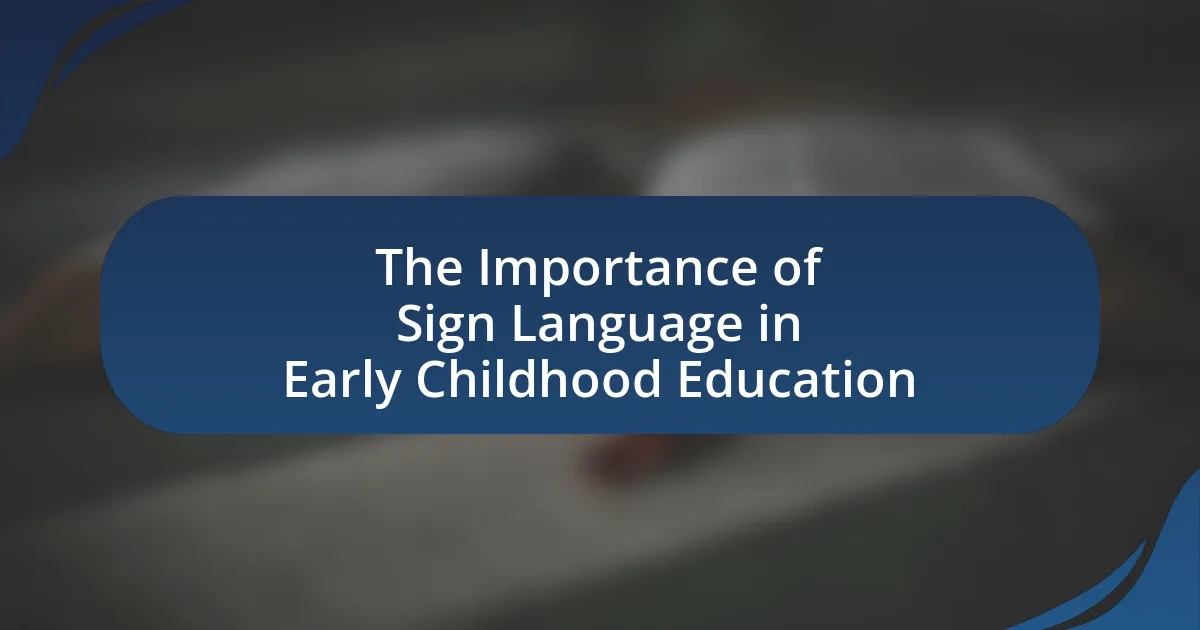The article focuses on the critical role of technology in enhancing learning for the Deaf community. It outlines how various tools, such as video conferencing, captioning software, and mobile applications, improve communication and accessibility, leading to better educational outcomes. Key technologies discussed include assistive listening devices, video relay services, and interactive learning platforms, which cater specifically to the needs of deaf learners. The article also addresses the challenges faced by deaf students without technology and highlights future trends, including advancements in artificial intelligence and augmented reality, that promise to further support deaf education.
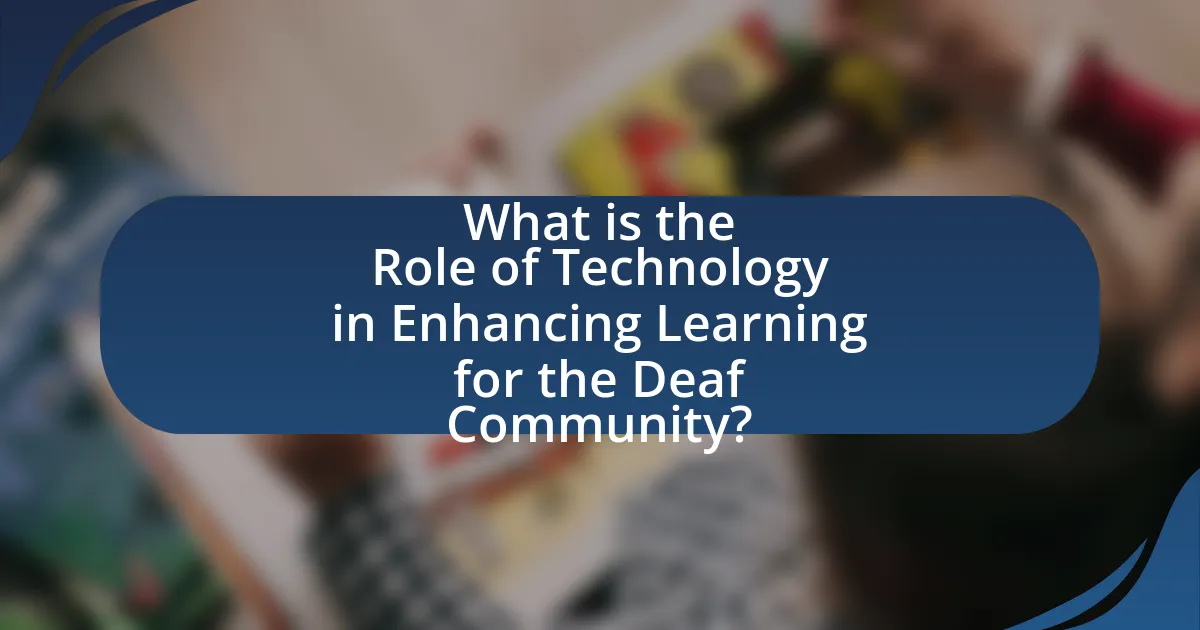
What is the Role of Technology in Enhancing Learning for the Deaf Community?
Technology plays a crucial role in enhancing learning for the Deaf community by providing accessible communication tools and educational resources. Tools such as video conferencing, captioning software, and mobile applications facilitate real-time communication and information sharing, allowing Deaf individuals to engage more effectively in educational settings. For instance, research by the National Deaf Center on Postsecondary Outcomes indicates that technology use significantly improves academic performance and social interaction among Deaf students. Additionally, online learning platforms offer tailored content that accommodates various learning styles, further supporting the educational needs of the Deaf community.
How does technology specifically cater to the needs of the deaf community?
Technology caters to the needs of the deaf community by providing tools that enhance communication, accessibility, and learning. For instance, video relay services enable deaf individuals to communicate via sign language with hearing people through a video interpreter, facilitating real-time conversations. Additionally, captioning services, such as real-time captioning in classrooms, ensure that deaf students can follow lectures and discussions effectively. Furthermore, educational apps and software designed specifically for deaf learners incorporate visual aids and interactive elements, which support diverse learning styles. Research indicates that the use of technology in educational settings significantly improves engagement and comprehension among deaf students, highlighting its critical role in fostering an inclusive learning environment.
What types of technology are most beneficial for deaf learners?
Assistive technologies such as hearing aids, cochlear implants, and visual communication tools are most beneficial for deaf learners. Hearing aids amplify sound, allowing users to perceive sounds more clearly, while cochlear implants provide direct stimulation to the auditory nerve, enabling improved hearing capabilities. Visual communication tools, including video relay services and captioning software, facilitate effective communication by providing visual access to spoken language. Research indicates that these technologies significantly enhance learning outcomes for deaf students by improving access to information and fostering better engagement in educational settings. For instance, a study published in the Journal of Deaf Studies and Deaf Education found that students using captioning services demonstrated higher comprehension levels compared to those who did not.
How do these technologies facilitate communication and learning?
Technologies facilitate communication and learning for the deaf community by providing accessible tools such as video conferencing, captioning software, and mobile applications that support sign language. These tools enable real-time interaction and information exchange, which is crucial for effective learning. For instance, video conferencing platforms allow deaf individuals to communicate through sign language, breaking down barriers that traditional audio-based communication methods impose. Additionally, captioning software enhances understanding by converting spoken language into text, making content more accessible during lectures and presentations. Research indicates that the use of such technologies significantly improves engagement and comprehension among deaf learners, as evidenced by studies showing higher academic performance when these tools are utilized in educational settings.
Why is technology important for the education of the deaf community?
Technology is important for the education of the deaf community because it facilitates access to information and communication, which are essential for effective learning. Tools such as video conferencing, captioning software, and educational apps enable deaf students to engage with content in ways that traditional methods may not support. For instance, research by the National Deaf Center on Postsecondary Outcomes indicates that technology-enhanced learning environments significantly improve academic performance and social interaction among deaf students. This demonstrates that technology not only bridges communication gaps but also enhances educational outcomes for the deaf community.
What challenges do deaf learners face without technology?
Deaf learners face significant challenges without technology, primarily in communication, access to information, and engagement in educational settings. Communication barriers arise as traditional verbal instruction is inaccessible, limiting interaction with teachers and peers. Access to information is hindered, as many educational resources, such as videos and online materials, are not designed with captions or sign language interpretation. Engagement in classrooms becomes difficult, as deaf learners may struggle to follow discussions or participate actively without technological aids like hearing devices or visual learning tools. These challenges can lead to lower academic performance and social isolation, as evidenced by studies indicating that deaf students often lag behind their hearing peers in literacy and overall educational achievement.
How does technology bridge the gap in traditional learning environments?
Technology bridges the gap in traditional learning environments by providing accessible tools and resources that cater to diverse learning needs. For instance, assistive technologies such as captioning software and speech-to-text applications enable deaf students to engage with auditory content in real-time, facilitating comprehension and participation. Research indicates that the use of such technologies can significantly improve learning outcomes; a study published in the Journal of Deaf Studies and Deaf Education found that students using captioning scored higher on comprehension tests compared to those who did not. Additionally, online platforms and interactive learning environments allow for personalized learning experiences, accommodating various learning styles and paces, which is crucial for students with hearing impairments.
What are the key technologies used in enhancing learning for the deaf community?
Key technologies used in enhancing learning for the deaf community include video relay services, captioning software, and mobile applications designed for sign language education. Video relay services enable real-time communication between deaf individuals and hearing people through a sign language interpreter, facilitating effective interaction. Captioning software provides real-time text representation of spoken content, ensuring that deaf learners can access audio materials in educational settings. Additionally, mobile applications like SignSchool and The ASL App offer interactive platforms for learning American Sign Language, making language acquisition more accessible and engaging. These technologies collectively improve educational outcomes by bridging communication gaps and providing tailored learning experiences for the deaf community.
How do assistive listening devices improve learning experiences?
Assistive listening devices improve learning experiences by amplifying sound and enhancing speech clarity for individuals with hearing impairments. These devices, such as hearing aids and FM systems, help students better engage with auditory information in classroom settings, leading to improved comprehension and retention of material. Research indicates that students using assistive listening devices demonstrate higher academic performance and increased participation in discussions compared to those without such support. For instance, a study published in the Journal of Deaf Studies and Deaf Education found that students using FM systems showed a 20% increase in their ability to understand spoken language in noisy environments, directly correlating to enhanced learning outcomes.
What role do video conferencing tools play in remote education for the deaf?
Video conferencing tools are essential in remote education for the deaf as they facilitate real-time communication through visual means, enabling effective interaction between educators and students. These tools support sign language interpretation and visual cues, which are crucial for comprehension and engagement in learning. Research indicates that platforms like Zoom and Microsoft Teams have integrated features such as screen sharing and video recording, which enhance accessibility and allow for a more inclusive educational experience. Additionally, studies show that the use of video conferencing in educational settings has led to improved academic performance and social interaction among deaf students, highlighting its significant role in bridging communication gaps in remote learning environments.
How can technology be integrated into educational settings for the deaf?
Technology can be integrated into educational settings for the deaf through the use of specialized tools such as video relay services, captioning software, and interactive learning platforms. These technologies facilitate communication and enhance learning experiences by providing real-time access to information and resources. For instance, video relay services allow deaf students to communicate with hearing individuals through sign language interpreters, thereby improving interaction in classroom settings. Additionally, captioning software ensures that spoken content is transcribed into text, making lectures and discussions accessible. Research indicates that the use of interactive learning platforms, which often include visual aids and gamified content, significantly boosts engagement and retention among deaf learners, as evidenced by studies showing improved academic performance in technology-enhanced environments.
What strategies can educators use to implement technology effectively?
Educators can implement technology effectively by integrating multimedia resources, utilizing assistive technologies, and fostering collaborative online environments. Integrating multimedia resources, such as videos and interactive simulations, caters to diverse learning styles and enhances engagement, which is crucial for the deaf community. Utilizing assistive technologies, like captioning software and sign language apps, ensures accessibility and supports communication. Fostering collaborative online environments through platforms that allow for real-time interaction and feedback promotes social learning and community building among deaf students. Research indicates that these strategies significantly improve learning outcomes and engagement in technology-enhanced education for the deaf community.
How can schools ensure accessibility in technology for deaf students?
Schools can ensure accessibility in technology for deaf students by implementing assistive technologies such as captioning software, sign language interpretation tools, and visual alert systems. These technologies facilitate communication and learning by providing real-time captions during lectures, enabling access to multimedia content, and ensuring that deaf students receive notifications through visual cues. Research indicates that the use of captioning can improve comprehension and retention of information for deaf students, as evidenced by a study published in the Journal of Deaf Studies and Deaf Education, which found that captioned videos significantly enhanced learning outcomes. Additionally, training educators on the effective use of these technologies is crucial for maximizing their benefits in the classroom.
What are the future trends in technology for the deaf community’s education?
Future trends in technology for the deaf community’s education include advancements in artificial intelligence, augmented reality, and improved accessibility tools. Artificial intelligence is being integrated into educational platforms to provide real-time captioning and sign language interpretation, enhancing communication and comprehension for deaf students. Augmented reality applications are being developed to create immersive learning experiences, allowing deaf learners to visualize complex concepts through interactive simulations. Additionally, improved accessibility tools, such as mobile apps that facilitate communication and learning, are becoming more prevalent, ensuring that educational resources are inclusive and tailored to the needs of the deaf community. These trends are supported by ongoing research and development in educational technology, which emphasizes the importance of accessibility and engagement in learning environments for deaf individuals.
How might artificial intelligence enhance learning for deaf learners?
Artificial intelligence can enhance learning for deaf learners by providing personalized educational experiences through adaptive learning technologies. These technologies analyze individual learning patterns and adjust content delivery accordingly, ensuring that deaf learners receive tailored support that meets their unique needs. For instance, AI-driven applications can convert spoken language into text or sign language in real-time, facilitating better comprehension of lessons. Research indicates that tools like speech-to-text software and sign language recognition systems significantly improve engagement and understanding among deaf students, as evidenced by studies showing increased academic performance when such technologies are utilized in educational settings.
What innovations are on the horizon that could further support deaf education?
Innovations on the horizon that could further support deaf education include advancements in artificial intelligence, augmented reality, and real-time captioning technologies. Artificial intelligence can enhance personalized learning experiences by adapting educational content to individual needs, while augmented reality can provide immersive learning environments that facilitate better understanding of complex concepts through visual aids. Real-time captioning technologies, such as automatic speech recognition systems, can improve accessibility in classrooms by providing instant text translations of spoken language, thereby allowing deaf students to engage more fully in discussions and lectures. These innovations are backed by ongoing research and development in educational technology, demonstrating their potential to significantly enhance learning outcomes for the deaf community.
What best practices should educators follow when using technology for deaf learners?
Educators should prioritize accessibility and engagement when using technology for deaf learners. This includes utilizing captioned videos, sign language interpretation, and visual aids to enhance comprehension. Research indicates that incorporating multimedia resources, such as interactive software and apps designed for deaf education, significantly improves learning outcomes. For instance, a study by the National Technical Institute for the Deaf found that students using technology with visual support demonstrated a 30% increase in information retention compared to traditional methods. Additionally, fostering a collaborative online environment encourages peer interaction, which is crucial for social learning among deaf students.
How can teachers assess the effectiveness of technology in their classrooms?
Teachers can assess the effectiveness of technology in their classrooms by evaluating student engagement, learning outcomes, and feedback. Specifically, they can track metrics such as participation rates, test scores, and assignment completion rates before and after technology implementation. Research indicates that technology can enhance learning experiences; for instance, a study by the National Center for Education Statistics found that students using interactive technology showed a 20% increase in engagement compared to traditional methods. Additionally, collecting qualitative feedback from students about their experiences with technology can provide insights into its impact on learning, particularly for the deaf community, where tailored technological tools can significantly improve communication and comprehension.
What resources are available for educators to stay updated on technology trends?
Educators can utilize various resources to stay updated on technology trends, including professional organizations, online courses, webinars, and educational technology blogs. Professional organizations such as the International Society for Technology in Education (ISTE) provide access to research, conferences, and networking opportunities that focus on the latest technology in education. Online platforms like Coursera and edX offer courses specifically on educational technology, allowing educators to learn at their own pace. Webinars hosted by technology companies and educational institutions frequently cover emerging tools and best practices. Additionally, blogs such as EdSurge and TeachThought regularly publish articles on current trends and innovations in educational technology, providing insights and practical applications for educators.

